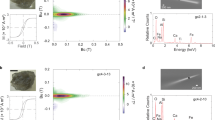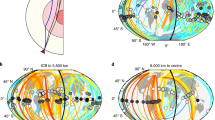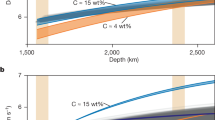Abstract
The best constraints on the internal structures of giant planets have historically originated from measurements of their gravity fields1,2,3. These data are inherently mostly sensitive to a planet’s outer regions, stymieing efforts to measure the mass and compactness of the cores of Jupiter2,4,5 and Saturn6,7. However, studies of Saturn’s rings have detected waves driven by pulsation modes within the planet8,9,10,11, offering independent seismic probes of Saturn’s interior12,13,14. The observations reveal gravity-mode pulsations, which indicate that part of Saturn’s deep interior is stable against convection13. Here, we compare structural models with gravity and seismic measurements from Cassini to show that the data can only be explained by a diffuse, stably stratified core–envelope transition region in Saturn extending to approximately 60% of the planet’s radius and containing approximately 17 Earth masses of ice and rock. This gradual distribution of heavy elements constrains mixing processes at work in Saturn, and it may reflect the planet’s primordial structure and accretion history.
This is a preview of subscription content, access via your institution
Access options
Access Nature and 54 other Nature Portfolio journals
Get Nature+, our best-value online-access subscription
$29.99 / 30 days
cancel any time
Subscribe to this journal
Receive 12 digital issues and online access to articles
$119.00 per year
only $9.92 per issue
Buy this article
- Purchase on Springer Link
- Instant access to full article PDF
Prices may be subject to local taxes which are calculated during checkout




Similar content being viewed by others
Data availability
A representative subset of the interior models generated in the course of this work is available upon request.
Code availability
The planetary structure and ToF code used to create the planetary models is available at https://github.com/chkvch/alice. The oscillation code and ancillary code related to the analysis are available upon request.
References
Kaspi, Y. et al. Jupiter’s atmospheric jet streams extend thousands of kilometres deep. Nature 555, 223–226 (2018).
Guillot, T. et al. A suppression of differential rotation in Jupiter’s deep interior. Nature 555, 227–230 (2018).
Iess, L. et al. Measurement and implications of Saturn’s gravity field and ring mass. Science 364, aat2965 (2019).
Wahl, S. M. et al. Comparing Jupiter interior structure models to Juno gravity measurements and the role of a dilute core. Geophys. Res. Lett. 44, 4649–4659 (2017).
Nettelmann, N. Low- and high-order gravitational harmonics of rigidly rotating Jupiter. Astron. Astrophys. 606, A139 (2017).
Militzer, B., Wahl, S. & Hubbard, W. B. Models of Saturn’s interior constructed with an accelerated concentric Maclaurin spheroid method. Astrophys. J. 879, 78 (2019).
Movshovitz, N., Fortney, J. J., Mankovich, C., Thorngren, D. & Helled, R. Saturn’s probable interior: an exploration of Saturn’s potential interior density structures. Astrophys. J. 891, 109 (2020).
Hedman, M. M. & Nicholson, P. D. Kronoseismology: using density waves in Saturn’s C ring to probe the planet’s interior. Astron. J. 146, 12 (2013).
Hedman, M. M. & Nicholson, P. D. More Kronoseismology with Saturn’s rings. Mon. Not. R. Astron. Soc. 444, 1369–1388 (2014).
French, R. G., McGhee-French, C. A., Nicholson, P. D. & Hedman, M. M. Kronoseismology III: waves in Saturn’s inner C ring. Icarus 319, 599–626 (2019).
Hedman, M. M., Nicholson, P. D. & French, R. G. Kronoseismology. IV. Six previously unidentified waves in Saturn’s middle C ring. Astron. J. 157, 18 (2019).
Marley, M. S. & Porco, C. C. Planetary acoustic mode seismology: Saturn’s rings. Icarus 106, 508–524 (1993).
Fuller, J. Saturn ring seismology: evidence for stable stratification in the deep interior of Saturn. Icarus 242, 283–296 (2014).
Mankovich, C., Marley, M. S., Fortney, J. J. & Movshovitz, N. Cassini ring seismology as a probe of Saturn’s interior. I. Rigid rotation. Astrophys. J. 871, 1 (2019).
Stevenson, D. J. Jupiter’s interior as revealed by Juno. Annu. Rev. Earth Planet. Sci. 48, 465–489 (2020).
Galanti, E. et al. Saturn’s deep atmospheric flows revealed by the Cassini Grand Finale gravity measurements. Geophys. Res. Lett. 46, 616–624 (2019).
Galanti, E. & Kaspi, Y. Combined magnetic and gravity measurements probe the deep zonal flows of the gas giants. Mon. Not. R. Astron. Soc. 501, 2352–2362 (2021).
Guillot, T. The interiors of giant planets: models and outstanding questions. Annu. Rev. Earth Planet. Sci. 33, 493–530 (2005).
Hubbard, W. B. Thermal structure of Jupiter. Astrophys. J. 152, 745–754 (1968).
French, R. G. et al. Deciphering the embedded wave in Saturn’s Maxwell ringlet. Icarus 279, 62–77 (2016).
Marley, M. S. Nonradial oscillations of Saturn. Icarus 94, 420–435 (1991).
Mankovich, C. R. Saturn’s rings as a seismograph to probe Saturn’s internal structure. AGU Adv. 1, e00142 (2020).
Gudkova, T. V. & Zharkov, V. N. Models of Jupiter and Saturn after Galileo mission. Planet Space Sci. 47, 1201–1210 (1999).
Guillot, T. A comparison of the interiors of Jupiter and Saturn. Planet Space Sci. 47, 1183–1200 (1999).
Saumon, D. & Guillot, T. Shock compression of deuterium and the interiors of Jupiter and Saturn. Astrophys. J. 609, 1170–1180 (2004).
Nettelmann, N., Püstow, R. & Redmer, R. Saturn layered structure and homogeneous evolution models with different EOSs. Icarus 225, 548–557 (2013).
Hubbard, W. B. & Militzer, B. A preliminary Jupiter model. Astrophys. J. 820, 80 (2016).
Leconte, J. & Chabrier, G. A new vision of giant planet interiors: impact of double diffusive convection. Astron. Astrophys. 540, A20 (2012).
Leconte, J. & Chabrier, G. Layered convection as the origin of Saturn’s luminosity anomaly. Nat. Geosci. 6, 347–350 (2013).
Nettelmann, N., Fortney, J. J., Moore, K. & Mankovich, C. An exploration of double diffusive convection in Jupiter as a result of hydrogen–helium phase separation. Mon. Not. R. Astron. Soc. 447, 3422–3441 (2015).
Vazan, A., Helled, R., Podolak, M. & Kovetz, A. The evolution and internal structure of Jupiter and Saturn with compositional gradients. Astrophys. J. 829, 118 (2016).
Debras, F. & Chabrier, G. New models of Jupiter in the context of Juno and Galileo. Astrophys. J. 872, 100 (2019).
Baillié, K., Colwell, J. E., Lissauer, J. J., Esposito, L. W. & Sremčević, M. Waves in Cassini UVIS stellar occultations. 2. The C ring. Icarus 216, 292–308 (2011).
Schöttler, M. & Redmer, R. Ab initio calculation of the miscibility diagram for hydrogen–helium mixtures. Phys. Rev. Lett. 120, 115703 (2018).
Fletcher, L. N. et al. Saturn’s tropospheric composition and clouds from Cassini/VIMS 4.6–5.1 μm nightside spectroscopy. Icarus 214, 510–533 (2011).
Fletcher, L. N., Orton, G. S., Teanby, N. A., Irwin, P. G. J. & Bjoraker, G. L. Methane and its isotopologues on Saturn from Cassini/CIRS observations. Icarus 199, 351–367 (2009).
Helled, R. & Guillot, T. Interior models of Saturn: including the uncertainties in shape and rotation. Astrophys. J. 767, 113 (2013).
Pollack, J. B. et al. Formation of the giant planets by concurrent accretion of solids and gas. Icarus 124, 62–85 (1996).
Lozovsky, M., Helled, R., Rosenberg, E. D. & Bodenheimer, P. Jupiter’s formation and its primordial internal structure. Astrophys. J. 836, 227 (2017).
Helled, R. & Stevenson, D. The fuzziness of giant planets’ cores. Astrophys. J. Lett. 840, L4 (2017).
Ormel, C., Vazan, A. & Brouwers, M. How planets grow by pebble accretion. III. Emergence of an interior composition gradient. Astron. Astrophys. 647, A175 (2021).
Müller, S., Helled, R. & Cumming, A. The challenge of forming a fuzzy core in Jupiter. Astron. Astrophys. 638, A121 (2020).
Wilson, H. F. & Militzer, B. Solubility of water ice in metallic hydrogen: consequences for core erosion in gas giant planets. Astrophys. J. 745, 54 (2012).
Wilson, H. F. & Militzer, B. Rocky core solubility in Jupiter and giant exoplanets. Phys. Rev. Lett. 108, 111101 (2012).
Wahl, S. M., Wilson, H. F. & Militzer, B. Solubility of iron in metallic hydrogen and stability of dense cores in giant planets. Astrophys. J. 773, 95 (2013).
Moll, R., Garaud, P., Mankovich, C. & Fortney, J. J. Double-diffusive erosion of the core of Jupiter. Astrophys. J. 849, 24 (2017).
Liu, S.-F. et al. The formation of Jupiter’s diluted core by a giant impact. Nature 572, 355–357 (2019).
Mirouh, G. M., Garaud, P., Stellmach, S., Traxler, A. L. & Wood, T. S. A new model for mixing by double-diffusive convection (semi-convection). I. The conditions for layer formation. Astrophys. J. 750, 61 (2012).
Wood, T. S., Garaud, P. & Stellmach, S. A new model for mixing by double-diffusive convection (semi-convection). II. The transport of heat and composition through layers. Astrophys. J. 768, 157 (2013).
Liu, J., Schneider, T. & Fletcher, L. N. Constraining the depth of Saturn’s zonal winds by measuring thermal and gravitational signals. Icarus 239, 260–272 (2014).
Stevenson, D. J. Reducing the non-axisymmetry of a planetary dynamo and an application to Saturn. Geophys. Astrophys. Fluid Dyn. 21, 113–127 (1982).
Stanley, S. A dynamo model for axisymmetrizing Saturn’s magnetic field. Geophys. Res. Lett. 37, L05201 (2010).
Cao, H. et al. The landscape of Saturn’s internal magnetic field from the Cassini Grand Finale. Icarus 344, 113541 (2020).
Zharkov, V. N. & Trubitsyn, V. P. Physics of Planetary Interiors (Pachart, 1978).
Militzer, B. & Hubbard, W. B. Ab initio equation of state for hydrogen–helium mixtures with recalibration of the giant-planet mass–radius relation. Astrophys. J. 774, 148 (2013).
Saumon, D., Chabrier, G. & van Horn, H. M. An equation of state for low-mass stars and giant planets. Astrophys. J. Suppl. 99, 713 (1995).
Miguel, Y., Guillot, T. & Fayon, L. Jupiter internal structure: the effect of different equations of state. Astron. Astrophys. 596, A114 (2016).
Thompson, S. L. ANEOS Analytic Equations of State for Shock Physics Codes Report sand89-2951 (Sandia National Laboratories, 1990); http://prod.sandia.gov/techlib/access-control.cgi/1989/892951.pdf
Lindal, G. F., Sweetnam, D. N. & Eshleman, V. R. The atmosphere of Saturn—an analysis of the Voyager radio occultation measurements. Astron. J. 90, 1136–1146 (1985).
Lindal, G. F. The atmosphere of Neptune: an analysis of radio occultation data acquired with Voyager 2. Astron. J. 103, 967 (1992).
Brassard, P., Fontaine, G., Wesemael, F., Kawaler, S. D. & Tassoul, M. Adiabatic properties of pulsating DA white dwarfs. I. The treatment of the Brunt–Vaeisaelae frequency and the region of period formation. Astrophys. J. 367, 601 (1991).
Salpeter, E. E. On convection and gravitational layering in Jupiter and in stars of low mass. Astrophys. J. Lett. 181, L83 (1973).
Stevenson, D. J. & Salpeter, E. E. The phase diagram and transport properties for hydrogen–helium fluid planets. Astrophys. J. Suppl. 35, 221–237 (1977).
Morales, M. A. et al. Phase separation in hydrogen–helium mixtures at mbar pressures. Proc. Natl Acad. Sci. USA 106, 1324–1329 (2009).
Morales, M. A., Hamel, S., Caspersen, K. & Schwegler, E. Hydrogen–helium demixing from first principles: from diamond anvil cells to planetary interiors. Phys. Rev. B 87, 174105 (2013).
Lorenzen, W., Holst, B. & Redmer, R. Demixing of hydrogen and helium at megabar pressures. Phys. Rev. Lett. 102, 115701 (2009).
Lorenzen, W., Holst, B. & Redmer, R. Metallization in hydrogen–helium mixtures. Phys. Rev. B 84, 235109 (2011).
Orton, G. S. & Ingersoll, A. P. Saturn’s atmospheric temperature structure and heat budget. J. Geophys. Res. 85, 5871–5881 (1980).
Conrath, B. J., Gautier, D., Hanel, R. A. & Hornstein, J. S. The helium abundance of Saturn from Voyager measurements. Astrophys. J. 282, 807–815 (1984).
Conrath, B. J. & Gautier, D. Saturn helium abundance: a reanalysis of Voyager measurements. Icarus 144, 124–134 (2000).
Sromovsky, L. A., Baines, K. H., Fry, P. M. & Momary, T. W. Cloud clearing in the wake of Saturn’s Great Storm of 2010–2011 and suggested new constraints on Saturn’s He/H2 ratio. Icarus 276, 141–162 (2016).
Koskinen, T. T. & Guerlet, S. Atmospheric structure and helium abundance on Saturn from Cassini/UVIS and CIRS observations. Icarus 307, 161–171 (2018).
Püstow, R., Nettelmann, N., Lorenzen, W. & Redmer, R. H/He demixing and the cooling behavior of Saturn. Icarus 267, 323–333 (2016).
Mankovich, C. R. & Fortney, J. J. Evidence for a dichotomy in the interior structures of Jupiter and Saturn from helium phase separation. Astrophys. J. 889, 51 (2020).
Asplund, M., Grevesse, N., Sauval, A. J. & Scott, P. The chemical composition of the Sun. Annu. Rev. Astron. Astrophys. 47, 481–522 (2009).
Chaplin, W. J. & Miglio, A. Asteroseismology of solar-type and red-giant stars. Annu. Rev. Astron. Astrophys. 51, 353–392 (2013).
Ledoux, P. The nonradial oscillations of gaseous stars and the problem of Beta Canis Majoris. Astrophys. J. 114, 373 (1951).
Dahlen, F. & Tromp, J. Theoretical Global Seismology (Princeton University Press, 1998); https://books.google.com/books?id=GWnuBws5gBEC
Hubbard, W. B. Concentric Maclaurin spheroid models of rotating liquid planets. Astrophys. J. 768, 43 (2013).
Foreman-Mackey, D., Hogg, D. W., Lang, D. & Goodman, J. emcee: the MCMC hammer. Publ. Astron. Soc. Pac. 125, 306–312 (2013).
Akaike, H. A new look at the statistical model identification. IEEE Trans. Autom. Control 19, 716–723 (1974).
Acknowledgements
C.R.M. thanks D. Stevenson for comments and the Juno Interiors Working Group for helpful discussions, and acknowledges support from the Division of Geological and Planetary Sciences at Caltech. J.F. is grateful for support through an Innovator Grant from The Rose Hills Foundation and through grant FG-2018-10515 from the Sloan Foundation.
Author information
Authors and Affiliations
Contributions
C.R.M. developed the planetary models, performed the calculations and analysis and led the preparation of the manuscript. J.F. developed the original oscillation code, contributed to the interpretation of the results and helped to write the manuscript.
Corresponding author
Ethics declarations
Competing interests
The authors declare no competing interests.
Additional information
Peer review information Nature Astronomy thanks Mark Marley and the other, anonymous, reviewer(s) for their contribution to the peer review of this work.
Publisher’s note Springer Nature remains neutral with regard to jurisdictional claims in published maps and institutional affiliations.
Extended data
Extended Data Fig. 1 Comparison of assumed shapes for Saturn’s composition gradient.
Helium distributions for our baseline linear composition profiles from Eq. (1) (a) are compared with those assuming sigmoid Z(r) and \(Y^{\prime} (r)\) in the transition region (b). The corresponding profiles of the heavy element mass fraction (c-d), mass density (e-f), and Brunt–Väisälä frequency (g-h) are also shown. 1,024 randomly selected models are shown for each sample, colored by log likelihood.
Extended Data Fig. 2 Eigenfunctions of m = − 2, l = 2 pseudomodes in Saturn.
a, Poloidal component of the horizontal displacement perturbation as a function of radius. b, Gravitational potential perturbation as a function of radius. Vertical line segments mark the outer boundary of the g mode cavity.
Extended Data Fig. 3 Eigenfunctions of m = − 2, l = 2 pseudomodes as a function of the width of the g mode cavity.
This is the sequence of interior models from Fig. 1, with our most likely model from the sample of Figs. 2-4 plotted in black. a, Brunt–Väisälä frequency as a function of radius. b-d, Gravitational potential perturbations associated with the three highest frequency pseudomodes in descending order. The identifications 2−2f and 2−2g2 hold for the best model (heavy black curves) but not necessarily others: moderate g mode cavity widths bring the modes in (c) and (d) farther away from an avoided crossing, causing the mode in (d) to become more like an f mode and (c) more like a g mode.
Extended Data Fig. 4 Relationship between ice to rock mass fraction, fice, and predicted central heavy element mass fraction (ice plus rock), Zin.
The red histogram shows the distribution of Zin in models with fice < 1/3; the blue histogram shows the same for models with fice > 2/3. Models are from the baseline case and colored by log likelihood as in Figs. 2-3. For models with predominantly icy cores, the preferred value of Zin is near unity, and vice versa.
Extended Data Fig. 5 Effect of superadiabatic thermal stratification.
Heavy element distributions for our baseline case (a) are compared with those for our superadiabatic case (b). (c-d) show profiles of Brunt–Väisälä frequency and mass density, and (e-f) show temperature profiles. 1,024 randomly selected models are shown for each sample, colored by log likelihood.
Extended Data Fig. 6 Results of seismology/gravity retrievals for different parameterizations of Saturn’s interior structure.
Physical properties are reported in terms of their means and standard deviations. In cases where distributions are significantly non-Gaussian, ranges corresponding to 5% and 95% quantiles are reported instead. Blank entries take the same values as in the baseline case.
Extended Data Fig. 7 Effect of deep zonal winds on sectoral mode frequencies.
a, two rotation laws of the form (S3) as a function of spherical radius inside Saturn. b, the same as a function of latitude at the cloud level. Observed winds are shown in dashed grey. For the nontrivial expansion labeled ‘Order 28 polynomial’ radial profiles (a) are shown at three latitudes marked with filled circles in (b). c, first-order perturbations to l = − m mode pattern speeds induced by the differential rotation.
Extended Data Fig. 8 Saturn’s m = − 2 mode spectrum including coupling across pseudomodes of different l.
Predicted semi-amplitude dτ of optical depth variations near outer Lindblad resonances of density waves in Saturn’s rings is plotted as a function of frequency Ωp and resonance radius in the ring plane. Colors indicate interior model likelihood with the same mapping as in Figs. 2-3. Red diamond symbols mark the frequencies and approximate amplitudes of spiral density waves observed at m = − 2 outer Lindblad resonances. From left to right these are the Maxwell ringlet wave20, W87.199, W84.6411, and W76.4410.
Supplementary information
Supplementary Information
Supplementary Figs. 1 and 2 and Discussion.
Rights and permissions
About this article
Cite this article
Mankovich, C.R., Fuller, J. A diffuse core in Saturn revealed by ring seismology. Nat Astron 5, 1103–1109 (2021). https://doi.org/10.1038/s41550-021-01448-3
Received:
Accepted:
Published:
Issue Date:
DOI: https://doi.org/10.1038/s41550-021-01448-3
This article is cited by
-
Thermal and Tidal Evolution of Ice Giants with Growing Frozen Cores: The Case of Neptune
Space Science Reviews (2024)
-
Tidal Dissipation in Giant Planets
Space Science Reviews (2024)
-
Long-Term Evolution of the Saturnian System
Space Science Reviews (2024)
-
Juno spacecraft gravity measurements provide evidence for normal modes of Jupiter
Nature Communications (2022)



